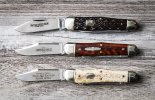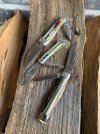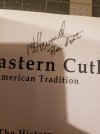This is straight from "Great Eastern Cutlery: An American Tradition" by David L. Anthony (2010):
"When the GEC founding fathers first looked at brand names that they would like to produce, several choices were considered. Bill is a traditionalist and favored names that represented wares of those old companies that prospered due to quality. Platts Brothers and Western States are prime examples of companies that utilized traditional methods combined with outstanding quality. Consideration was given to Western Cutlery as well, but when the corporation attorneys looked at these possible choices, they advised against it, because they were either already owned by others to too close in name to existing companies. So the search continued until the Northfield name came up. UN-X-LD was just the type of name that GEC loved and knew it represented a by-gone era in cutlery history. It should be noted that the UN-X-LD name was used on a series of knives made in Germany in the 1990s when Mr. Parker (TRVKA) Tennessee River Valley Knife Association owned the trademark. He had the factory in Germany that made Bulldog Brand manufacture these knives. Again, a lesson in being able to “read the knife” will allow you to easily discern these knives from the original Northfields and the new GEC version.
In addition, Bill was well acquainted with the historical aspects of nearby Tidioute in the world of cutlery and chose to add the Tidioute Brand to the line as well. It was these choices that enticed many of the traditionalists and historians alike to give these knives more than just a quick glance. It is obvious that the same pride associated with those old names many years ago is still viewed with respect today by the staff at GEC. Not a marketing gimmick, but rather a way to pay homage to those that help develop the industry as we know it today.
The knives produced so far have been in patterns familiar to the traditionalist and fine examples of useful tools. Remember that fact from earlier discussions? They are still tools, each designed with a purpose. Elephant toenails/Sunfish/Pumpkin See knives weren’t made to please collectors of big knives, originally these were marketed as rope knives. Designed for the oilfield industry, remember the Tidioute oilfields? These knives were used to cut heavy rope and help for rigs in the oil industry. The knife was laid on the rope and then a mallet was smacked down on it to make a clean cut. It is doubtful that your local hardware store has any idea about this once common practice nowadays. Unless you’re a true old-school outdoorsman, the trapper pattern will probably baffle you as well. After all, what uses would that rounded edge on the secondary blade have in today’s regular society? The list goes on an on, but the early tools all had practical functions for which they were designed.
One point that Bill is adamant about, is that these knives are not reproductions of exact Northfield or Tidioute knives. They didn’t take the old knives and try to make exact reproductions of them. GEC knives have a character all their own. Each pattern is based on traditional styles and values, but not a line-by-line reproduction meant to confuse or fool a would be collector. What is a fact is that each knife is meant to replicate something of the past. Again, not the exact reproduction of an exact knife manufactured by Northfield or Tidioute, but a replication of the quality that these companies produced. The attention to detail surrounding their construction and materials used is what sets them apart from many of today’s manufacturers as well as the similarities that GEC shares with the old masters from a by-gone era. Northfield and Tidioute have long since closed their doors and could have been easily forgotten, but their rebirth at GEC assures that none of us that cherish cutlery history and quality will ever forget them now. What does the future hold for GEC? For the most part, all of GEC’s materials are from the U.S.A. One exception might be the gorgeous sambar stag imported from Sri Lanka, Pakistan and India. The goal is to keep their product as American as possible and by keeping the product lines fresh for their customers, offering a little something different each year with hands-on construction at a fair price. Is Great Eastern Cutlery born in the U.S.A.? Damn right it is.”





